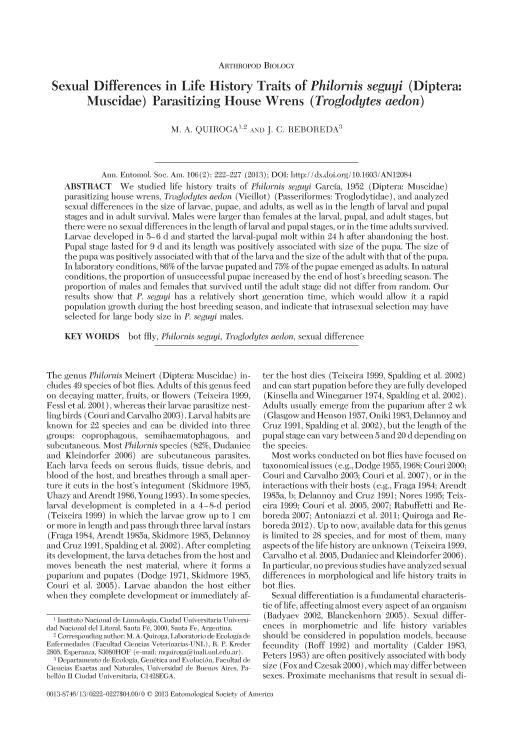Artículo
Sexual differences in life history traits of Philornis Weguyi (diptera: muscidae) parasitizing house wrens (Troglodytes Aedon)
Fecha de publicación:
10/2013
Editorial:
Entomological Society of America
Revista:
Annals Of The Entomologycal Society Of America
ISSN:
0013-8746
Idioma:
Inglés
Tipo de recurso:
Artículo publicado
Clasificación temática:
Resumen
We studied life history traits of Philornis seguyi Garcõ´a, 1952 (Diptera: Muscidae) parasitizing house wrens, Troglodytes aedon (Vieillot) (Passeriformes: Troglodytidae), and analyzed sexual differences in the size of larvae, pupae, and adults, as well as in the length of larval and pupal stages and in adult survival. Males were larger than females at the larval, pupal, and adult stages, but there were no sexual differences in the length of larval and pupal stages, or in the time adults survived. Larvae developed in 5Ð 6 d and started the larval-pupal molt within 24 h after abandoning the host. Pupal stage lasted for 9 d and its length was positively associated with size of the pupa. The size of the pupa was positively associated with that of the larva and the size of the adult with that of the pupa. In laboratory conditions, 86% of the larvae pupated and 75% of the pupae emerged as adults. In natural conditions, the proportion of unsuccessful pupae increased by the end of hostÕs breeding season. The proportion of males and females that survived until the adult stage did not differ from random. Our results show that P. seguyi has a relatively short generation time, which would allow it a rapid population growth during the host breeding season, and indicate that intrasexual selection may have selected for large body size in P. seguyi males.
Palabras clave:
Botfly Parasitism
,
Sexual Differences
,
Philornis Seguyi
,
House Wren
Archivos asociados
Licencia
Identificadores
Colecciones
Articulos(IEGEBA)
Articulos de INSTITUTO DE ECOLOGIA, GENETICA Y EVOLUCION DE BS. AS
Articulos de INSTITUTO DE ECOLOGIA, GENETICA Y EVOLUCION DE BS. AS
Citación
Quiroga, M. A.; Reboreda, Juan Carlos; Sexual differences in life history traits of Philornis Weguyi (diptera: muscidae) parasitizing house wrens (Troglodytes Aedon); Entomological Society of America; Annals Of The Entomologycal Society Of America; 106; 2; 10-2013; 222-227
Compartir
Altmétricas




